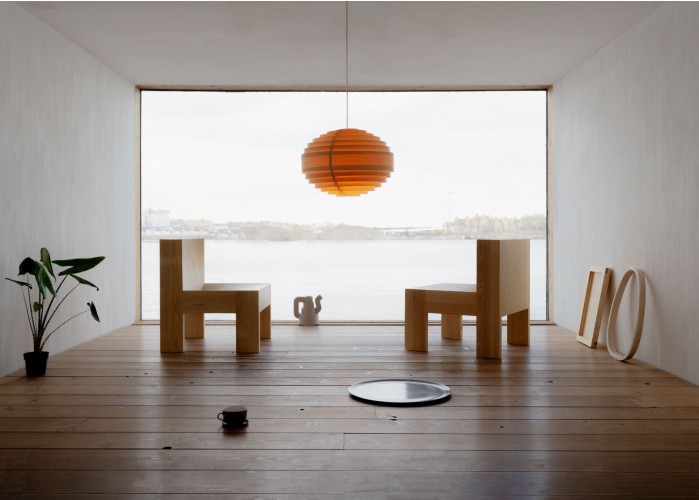Συνέντευξη με τη Laure Jaffuel
DS.WRITER:
Σοφία Θρουβάλα
H Laure Jaffuel είναι Γαλλίδα σχεδιάστρια. Ζει και εργάζεται τόσο σε Γαλλία όσο και Ελλάδα, διατηρώντας ένα στούντιο στην Αθήνα. Το ενδιαφέρον της στρέφεται στη δημιουργία σχεδιαστικών εγκαταστάσεων και γεγονότων, με επίκεντρο τα αντικείμενα και τη σχέση του κοινού με αυτά. Έχει συνεργαστεί με σημαντικούς αρχιτέκτονες, φορείς, οργανισμούς και σχεδιαστές. Η πιο πρόσφατη μεγάλη της δουλειά ήταν στο Κέντρο Pompidou του Παρισιού. Στην Ελλάδα έχει συνεργαστεί με το ίδρυμα Ωνάσης για τη δημιουργία ενός συλλεκτικού τόμου με τίτλο “ΟΛΗ ΜΕΡΑ ΟΛΗ ΝΥΧΤΑ”, και με τη Vague Greece με την “πολυκατοικία” της, εμπνευσμένη από το αθηναϊκό τοπίο. Έχει διδάξει σε μεταπτυχιακό πρόγραμμα design του τμήματος τέχνης και αρχιτεκτονικής, του Sandberg Institute του Amsterdam.
-Laure, θα ήθελες να μας συστηθείς; Με τι ασχολείσαι;
Είμαι designer από τη Νότια Γαλλία, μεγάλωσα δίπλα σε ακτή της Μεσογείου. Σχεδιάζω έπιπλα, εσωτερικούς χώρους, σκηνικά, και κάνω καλλιτεχνική επιμέλεια σε events και πολιτιστικά/κοινωνικά projects. Επίσης, έχω διδάξει στο Sandberg Institute του Άμστερνταμ, στο μεταπτυχιακό πρόγραμμα Studio for Immediate Space, αλλά σταμάτησα πριν την πανδημία. Γενικά, ενδιαφέρομαι για την παραγωγή αντικειμένων ή χώρων που λειτουργούν ως μέσα κοινωνικοποίησης. Το πλαίσιο στο οποίο βρίσκεται η δουλειά μου είναι πολύ σημαντικό. Προσπαθώ να δίνω προσοχή τόσο στο design όσο και στην κατασκευή των καταστάσεων που πλαισιώνουν τα αντικείμενα. Οι πρακτικές μου αφορούν πολλά επίπεδα και πλευρές. Θέτω στο ίδιο επίπεδο τον σχεδιασμό χώρων, αντικειμένων, events, καταστάσεων, ήχου, πάρτι, σκηνικών ή εκδόσεων. Οι συνεργασίες είναι πάντα συναρπαστικό μέρος της δουλειάς μου, είτε συνεργάζομαι με καλλιτέχνες, τεχνίτες, DJs, αρχιτέκτονες, συγγραφείς κ.α., είτε απλώς προσκαλώ ανθρώπους να συμβάλλουν ή να συμμετέχουν στα projects μου. Εκτιμώ ιδιαιτέρως την τοπική, χειροποίητη παραγωγή προϊόντων, με τις γνώσεις των τεχνιτών και τα υλικά που βρίσκονται στο άμεσο περιβάλλον μου.
-Πώς αποφάσισες να έρθεις να μείνεις στην Ελλάδα;
Γεννήθηκα και μεγάλωσα στη νότια Γαλλία και ήθελα να ζήσω σε μια χώρα κοντά στη μεσογειακή μου κουλτούρα αλλά να παραμείνω στην Ευρώπη. Η Ελλάδα φαινόταν πολύ ενδιαφέρον μέρος να βρίσκεται κανείς, και γι’ αυτό ήρθα αρκετές φορές, έκανα τη δοκιμή μου και μου φάνηκε πολύ συναρπαστικό μέρος, οπότε αποφάσισα να μείνω. Ήταν έρωτας με την πρώτη ματιά!
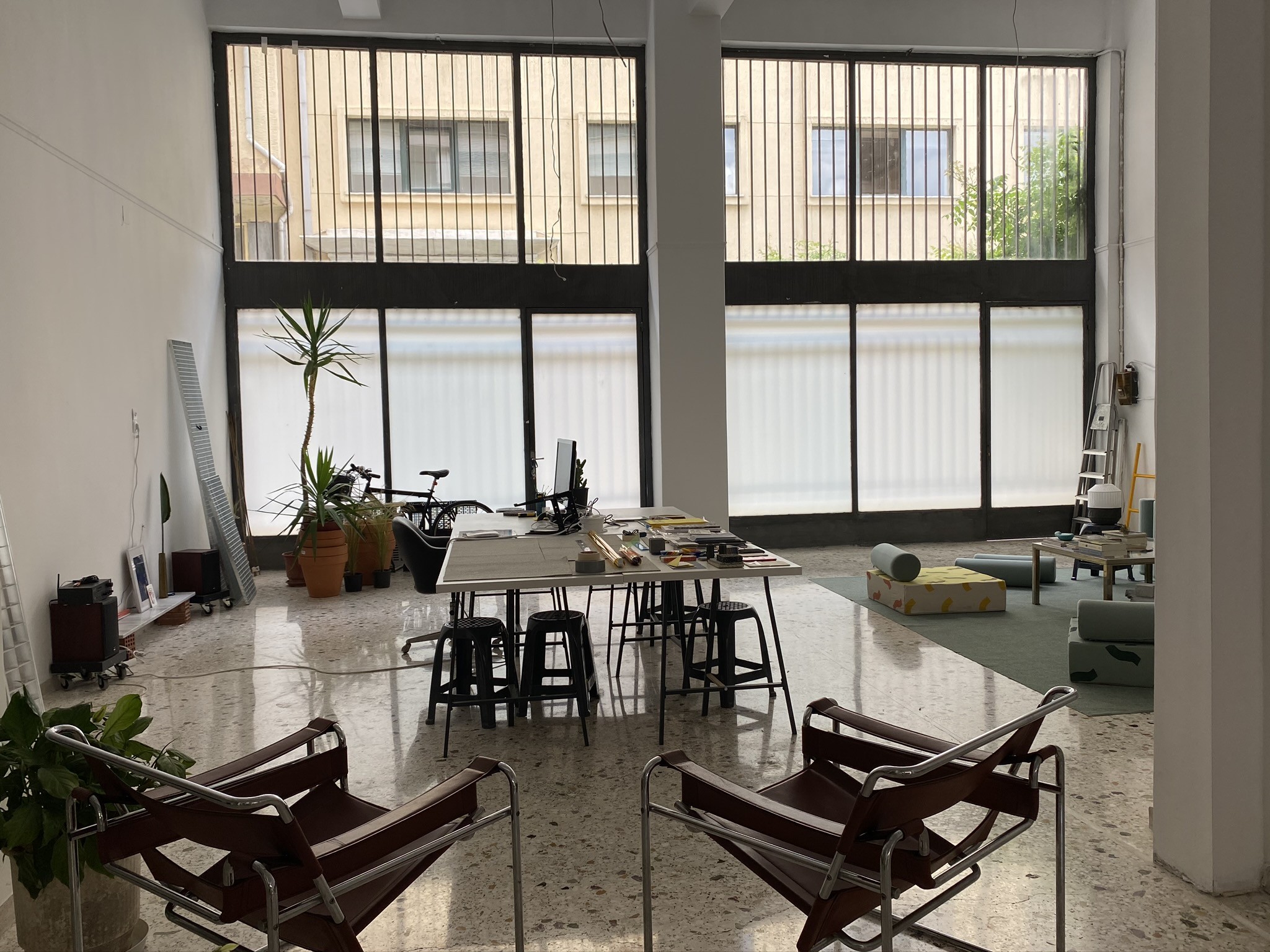 LaureStudio_Athens_lowres_groundfloor
LaureStudio_Athens_lowres_groundfloor
-Είσαι από τους λίγους γνωστούς ξένους designers που κατοικούν στην Ελλάδα. Θα ήθελες να μοιραστείς την εμπειρία σου, για το πώς είναι να δουλεύεις σε μια χώρα που βρίσκεται σε οικονομική κρίση;
Αρχικά, ευχαριστώ που το λέτε αυτό! Χαίρομαι πολύ που κάνουμε αυτή τη συνέντευξη, που νιώθω ότι, ακόμα και ως ξένη, είμαι κομμάτι τής τοπικής Αθηναϊκής σκηνής. Μέχρι στιγμής είναι μια πάρα πολύ καλή εμπειρία! Ως περιβάλλον για να ζεις, η Αθήνα, και γενικά η Ελλάδα, είναι πολύ ενδιαφέρον μέρος. Από άποψη δουλειάς, όταν έφτασα υπήρχαν αρκετές προκλήσεις, η οικονομική κατάσταση ήταν πολύ εύθραυστη -και ακόμα είναι-, οπότε δεν υπάρχουν πολλοί πελάτες. Από την άλλη, αυτή η κατάσταση διαμορφώνει μια πολύ εναλλακτική σκηνή, που είναι προσανατολισμένη περισσότερο προς τα projects και λιγότερο προς τις παραγγελίες πελατών, οπότε ήταν πάρα πολύ εύκολο να δημιουργήσω ένα δίκτυο και να τρέξω διάφορα μικρά projects σε πολιτιστικούς και κοινωνικούς χώρους όπως το Communitism. Ασχολήθηκα σε βάθος με συνεργασίες αυτού του είδους, οι οποίες υπήρξαν πολύ γόνιμες, και ίσως σε άλλες χώρες θα χρειάζονταν περισσότερο χρόνο ή θα ήταν πιο δύσκολο να συμβούν.
Το δεύτερο πράγμα που βρήκα πάρα πολύ ενδιαφέρον, και νομίζω σχετίζεται με τον τρόπο που η Αθήνα έχει οικοδομηθεί και αναπτυχθεί, είναι το γεγονός πως είναι μεν πρωτεύουσα, αλλά υπάρχουν τεχνίτες στο κέντρο της πόλης. Έχετε ακόμα πολλούς μεταλλουργούς, ξυλουργούς, κεραμιστές ή υαλουργούς, και όλες αυτές οι τέχνες είναι ακόμα παρούσες στην πόλη και εύκολα προσβάσιμες. Ως designer αυτό είναι κάτι σπάνιο για εμένα, καθώς δεν το συναντάμε πια στην Ευρώπη. Έκανα πολλά projects εδώ με τοπικούς τεχνίτες και ατελιέ.
LaureStudio_Athens_lowres_groundfloor2
-Πιστεύεις πως η Ελλάδα είναι ή μπορεί να γίνει ένα περιβάλλον φιλικό προς τους designers;
Νομίζω πως, από τη μία δεν είναι ακόμα φιλικό προς τους designers, καθώς δεν υπάρχει μεγάλη σκηνή ή κουλτούρα design. Η Carwan είναι μια από τις πρώτες γκαλερί design, που άνοιξε πολύ πρόσφατα στην Αθήνα. Από την άλλη, από πλευράς παραγωγής, νομίζω πως είναι πολύ φιλική, με την έννοια ότι σου επιτρέπει να φτιάξεις πράγματα, να παραγάγεις έργο με τοπικά εργαστήρια. Σαν σκηνή με εμπνέει πολύ και ελπίζω να αναπτυχθεί σε αυτή την κατεύθυνση. Πιστεύω πως σήμερα, ως designer, είναι κομβικής σημασίας να θέτω ζητήματα παραγωγής. Η παραγωγή τοπικά, σε στενή συνεργασία με τεχνίτες, έγινε σημαντικό κομμάτι τής δημιουργικής μου διαδικασίας. Ως designer, αφιερώνω στο στούντιο τον ίδιο χρόνο που αφιερώνω και στο να ψάχνω υλικά ή να επισκέπτομαι εργαστήρια και ατελιέ με τα οποία συνεργάζομαι.
-Μπορούμε να υποθέσουμε πως η εμπειρία αυτής της πόλης είναι η κύρια ιδέα πίσω από τη συνεργασία σου με τη Vogue Greece και το έργο-εγκατάστασή σου “The Polykatoikia, The Sun, The Column and The Night”, και την έκδοση του “All Day All Night” από το Ίδρυμα Ωνάση. Ποιο είναι το πιο ενδιαφέρον πράγμα αυτού του τοπίου που θες να μοιραστείς μαζί μας;
Σκοπός μου σε αυτό το project ήταν να κοιτάξω το Αθηναϊκό τοπίο από την οπτική του ξένου, καθώς φυσικά δε μεγάλωσα εδώ και δεν είναι ακριβώς δική μου κουλτούρα, οπότε έχω διαφορετική οπτική στα πράγματα. Ως designer, με ενδιαφέρει γενικά πάρα πολύ ο δημόσιος χώρος. Είναι κάτι που έχω ερευνήσει αρκετά, και έχω συμμετάσχει σε κάποια projects σε δημόσιο χώρο, οπότε όταν μετακόμισα εδώ μου φάνηκε ενδιαφέρον να μελετήσω το τι συμβαίνει στον δημόσιο χώρο της Αθήνας. Η ιστορία ξεκίνησε με το Onassis Air residency, στη διάρκεια της πρώτης καραντίνας το 2020, ένα τρίμηνο residency κατά το οποίο επικεντρώθηκα στην έρευνα του δημόσιου χώρου της Αθήνας. Στο τέλος αυτής της έρευνας, το Ίδρυμα Ωνάση, σε συνεργασία με την Dolce Publishing, εξέδωσαν το ALL DAY ALL NIGHT / ΟΛΗ ΜΕΡΑ, ΟΛΗ ΝΥΧΤΑ, μια δίγλωσση έκδοση στα Αγγλικά και στα Ελληνικά. Αποτελεί μια συλλογή από αρκετά κείμενα, εικόνες, αφίσες, που προωθούν πλασματικά events που λαμβάνουν χώρα στην Αθήνα, καθώς και αποσπάσματα από διάφορες συνεντεύξεις που πήρα από διάφορους ανθρώπους τής τοπικής σκηνής: από αρχιτέκτονες και πολεοδόμους, μέχρι εργάτες του Δήμου, πωλητές σε περίπτερα, γείτονες, καλλιτέχνες, ακτιβιστές και κοινωνικούς λειτουργούς.
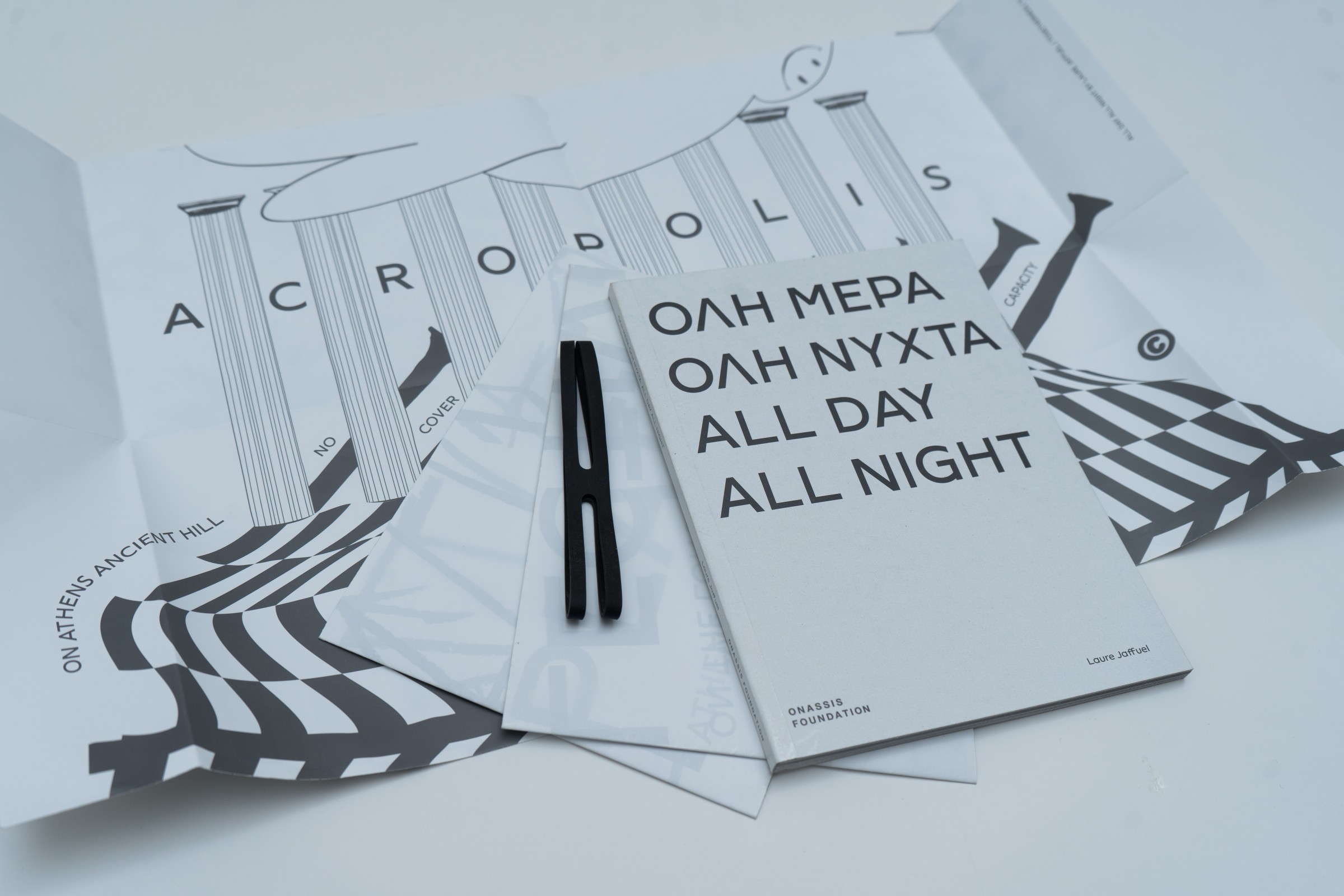
ALLDAYALLNIGHT_publication_photoby_RonnyS
Ήταν πολύ ευχάριστο που είχα τον χρόνο να κάνω αυτή την έρευνα και μετά να τη συμπτύξω και σε βιβλίο! Με βοήθησε να καταλάβω πώς έχει οικοδομηθεί η Αθήνα, πώς λειτουργεί αλλά και πώς δυσλειτουργεί, καθώς, νομίζω, ο δημόσιος χώρος εδώ είναι πολύ πλούσιος και ζωντανός, αλλά η πόλη δυσλειτουργεί μερικές φορές. Έχει πολλές αντιφάσεις αλλά βλέπω ομορφιά σε αυτό το χάος, καθώς είναι οργανικό, υπάρχει πραγματική δημόσια ζωή. Οι άνθρωποι, για παράδειγμα, οικειοποιούνται τον χώρο στους δρόμους, πράγμα που σπανίζει στις πόλεις που θέλουν να έχουν έναν “καθαρό” δημόσιο χώρο. Εδώ υπάρχουν πολλά προβλήματα, αλλά υπάρχει και πολλή ζωή, είναι μια πόλη με μια δική της, ξεχωριστή έννοια. Έχει κατασκευαστεί χωρίς κανόνες, χωρίς πολεοδομικές ζώνες ή όραμα, ταυτόχρονα “από τον λαό”, “κατά του λαού” και “με τον λαό”. Είναι ένα πολύπλοκο θέμα, αλλά το βρίσκω πολύ ενδιαφέρον.
Μετά, μου πρότεινε η Vogue να κάνω ένα “carte blanche” project, και η ιδέα ήταν να εμπνευστώ από την Αθήνα. Έψαχνα για το εμβληματικό πράγμα που οικοδομεί την πόλη και, φυσικά, η πολυκατοικία ήταν η βασική σκέψη. Μετά ήταν ο ήλιος, η νύχτα και ο κίονας. Ήταν όμως set σχεδιασμένο για τη φωτογράφιση, οπότε ήταν κάπως πιο αφηρημένο, αλλά ήταν εμπνευσμένο πλήρως από την πόλη όσον αφορά τα χρώματα και τα σχέδια.
-Λατρέψαμε το installation project "Ecole Pro (Space)", που δημιούργησες μαζί με τον Leopold Banchini στο Centre Pompidou. Ποια ήταν η κύρια ιδέα αυτής της εγκατάστασης;
Ο Banchini μου πρότεινε να συνεργαστώ μαζί του πάνω σε αυτό το project το 2018, και ήταν ανάθεση από ένα ειδικό τμήμα του Centre Pompidou, το οποίο ασχολείται με τη διαμεσολάβηση του κοινού, διοργανώνοντας δραστηριότητες εκτός της κύριας έκθεσης. Τρέχουν δύο προγράμματα, ένα για παιδιά και ένα για εφήβους, και ήθελαν να διαμορφώσουν και ένα για ενήλικες. Έτσι, μας ανέθεσαν να σχεδιάσουμε αυτόν τον χώρο, αλλά οι σχεδιαστικοί στόχοι ήταν πολύ δύσκολοι, καθώς το δωμάτιο που διέθεταν ήταν μόλις 100 τ.μ. και ήθελαν να υπάρχουν πολλές λειτουργίες: μια κουζίνα, ένα ατελιέ, ένα δωμάτιο συνεδριάσεων, ένα καφέ, ένα lounge, αποθηκευτικός χώρος και ένας μεγάλος χώρος για workshops που απαιτούν σωματική κίνηση. Επομένως, αποφασίσαμε να δουλέψουμε κάτω από το πάτωμα, με αποτέλεσμα να μπορούν να ανοίγουν οι πόρτες για τη χρήση μιας λειτουργίας, και να κλείνουν όλες ώστε να χρησιμοποιηθεί όλος ο χώρος ως ένας.

Laure Jaffuel_mille formes_art center_photoby_Elina Belou_3
-Είναι η αλληλεπίδραση του κοινού, και η Σχεσιακή Αισθητική γενικότερα, κάτι που σκοπεύεις να παρέχεις με τα έργα σου; Ενθαρρύνεις την επικοινωνία μεταξύ δημιουργού και κοινού;
Ναι. Στην περίπτωση του Centre Pompidou, πρόκειται για έναν πολύ ξεχωριστό χώρο επειδή είναι στη μέση της συλλογής, και όταν δε χρησιμοποιείται από workshop είναι ανοιχτό στο κοινό, κάτι που είναι σπάνιο σε τέτοιες περιπτώσεις. Μπορώ να δω τη σύνδεση με τη σχεσιακή αισθητική, μια καλλιτεχνική τάση που ήθελε την απομάκρυνση από το μουσείο και τη χρήση τής αλληλεπίδρασης του κοινού ως μορφής τέχνης. Εμείς φέραμε το κοινό μέσα στο μουσείο. Είναι κάτι που θεωρώ ενδιαφέρον και το συσχετίζω με τη δουλειά μου, επειδή, ως designer, δουλεύω κυρίως σε κοινωνικούς χώρους και στον δημόσιο χώρο. Με ενδιαφέρει οποιοδήποτε είδος χώρου που μπορεί να προκαλέσει την αλληλεπίδραση με το κοινό, ή οποιοδήποτε αντικείμενο ή event. Μελετάω πώς να κατασκευάζω χώρους που θα προκαλέσουν συλλογικές συναντήσεις: μπορεί να είναι ένα κλαμπ, ένα γραφείο, ο δρόμος, μια κατάληψη, ένα πάρτι ή ένα κέντρο τέχνης. Προσπαθώ να δουλεύω σε ποικιλόμορφα πλαίσια και περιβάλλοντα. Μπορεί να είναι ένα δημόσιο παγκάκι, που είναι ένα πολύ πολιτικό αντικείμενο, για παράδειγμα. Επιπλέον, συμπεριλαμβάνω από πολύ νωρίς στη δημιουργική μου διαδικασία τον παράγοντα του κοινού ή του θεατή/επισκέπτη/χρήστη.

Laure Jaffuel_mille formes_art center_photoby_Elina Belou
-Για ποιο άλλο project σου είσαι πιο περήφανη μέχρι στιγμής; Μπορείς να μας πεις γιατί;
Θα αναφέρω δύο projects που έχω κάνει, το ένα στη Γαλλία και το άλλο στην Ελλάδα. Το πρώτο είναι ένα κέντρο τέχνης που ονομάζεται Mille Formes και το σχεδίασα το 2019, στην πόλη Clermont-Ferrand. Είναι το πρώτο κέντρο τέχνης στη Γαλλία εξ ολοκλήρου αφιερωμένο σε παιδιά από 0 έως 6 ετών, και αναπτύχθηκε επίσης σε συνεργασία με το Centre Pompidou. Με κάλεσαν να σχεδιάσω όλο το εσωτερικό τού κέντρου, αλλά και να οργανώσω τους χώρους αυτού του μεγάλου όγκου. Δούλεψα πρώτα με την ομάδα του Δήμου και το Centre Pompidou, για να αναπτύξουμε πρώτα το πρόγραμμα μαζί και μετά να κάνω τον σχεδιασμό. Καθώς σχεδιάζαμε το project, θεώρησα σημαντικό να σχεδιάσουμε και τον εξωτερικό χώρο που είναι μπροστά από το μουσείο. Σχεδιάσαμε έναν μικρό δημόσιο χώρο, ώστε να προσκαλέσουμε τον κόσμο προς τα μέσα και να αναπτύξουμε μια σχέση με τη γειτονιά και την πόλη. Εκεί σχεδίασα επίσης τα δημόσια έπιπλα και τα εξωτερικά κομμάτια, σε συνεργασία με την αρχιτέκτονα Sharmily Guyot. Όταν σχεδιάζεις ένα κέντρο τέχνης, πρέπει να ξεκινάς από τον δρόμο, πρέπει να ξεκινάς από το έξω για να προσελκύσεις τον κόσμο στο μέσα. Αυτό το κέντρο έχει πολλούς χώρους: ένα ατελιέ, έναν εκθεσιακό χώρο, ένα καφέ, έναν χώρο για χορό και θέαμα, τον χώρο για τα μωρά και έναν χώρο για προβολές. Υπάρχουν μικτοί τύποι δραστηριοτήτων και τυπολογίες χώρων μέσα στο κτίριο. Επομένως, το θεωρώ το πιο επιτυχημένο project που έκανα πριν την πανδημία.
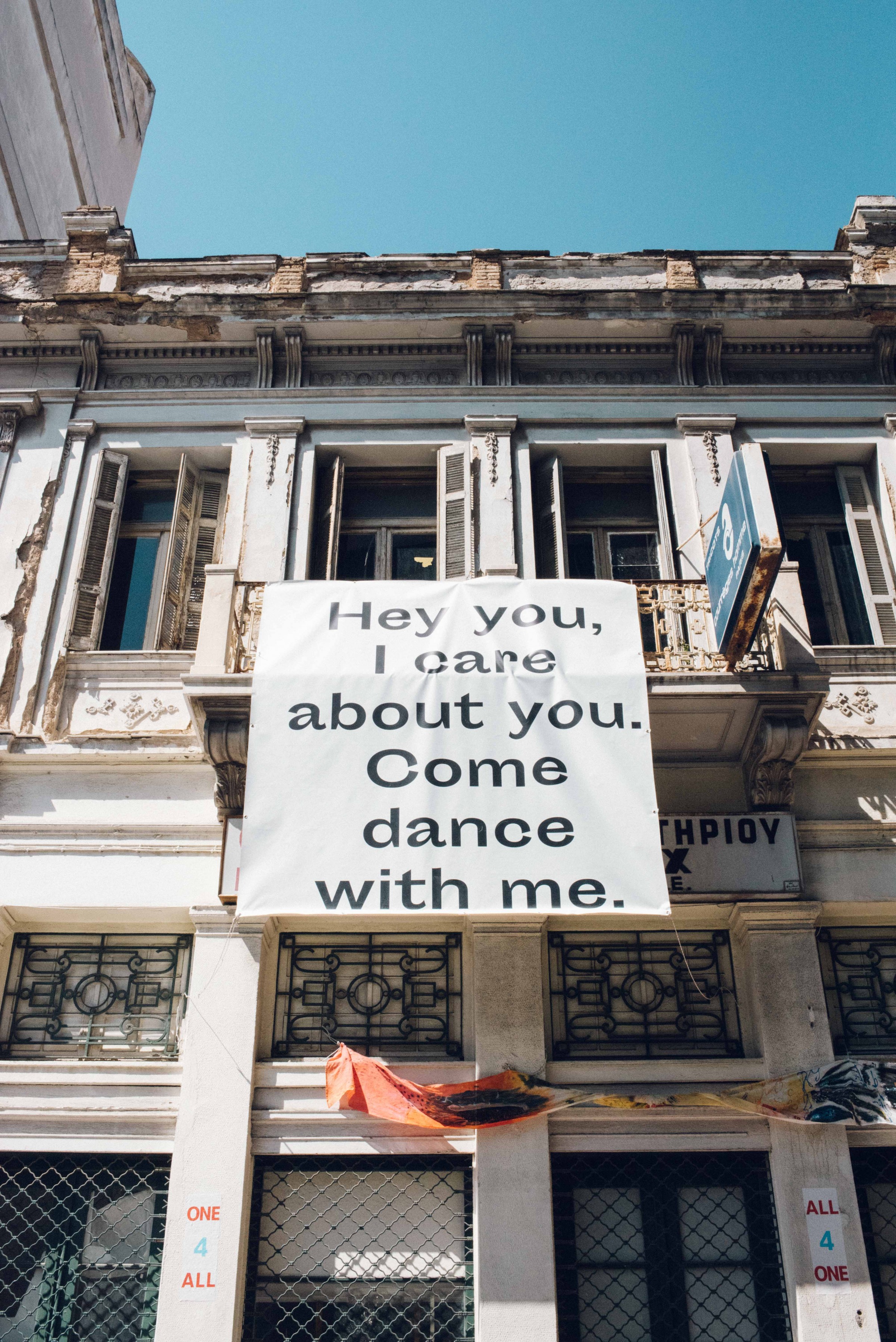
LaureJaffuel_Come Dance with me_Communitism_photoby_ElinaBelou_
Το δεύτερο που μου άρεσε πολύ, εδώ στην Ελλάδα, ήταν η συνεργασία με τον χώρο του Communitism, το εναλλακτικό αυτό πολιτιστικό και κοινωνικό κέντρο στο Μεταξουργείο, όπου τοποθέτησα δύο banners στην πρόσοψη του κτιρίου, καθώς ήθελα να απευθυνθώ στους ανθρώπους στον δρόμο. Τα banners, ένα στα ελληνικά και ένα στα αγγλικά, έλεγαν “Hey you, I care about you. Come dance with me” / “Γεια σου, νοιάζομαι για εσένα. Έλα να χορέψεις μαζί μου”. Φτιάξαμε επίσης t-shirts με την ίδια φράση, με μεταξοτυπία, τα οποία πουλήσαμε για να μαζέψουμε χρήματα για το κτίριο. Ήταν μια πάρα πολύ όμορφη εμπειρία το να κάνω αυτό το project και να γνωρίσω αυτή την κοινότητα, αν και ήταν λίγο εκτός της συνήθους πρακτικής μου, αλλά είχε να κάνει με τον δημόσιο χώρο.




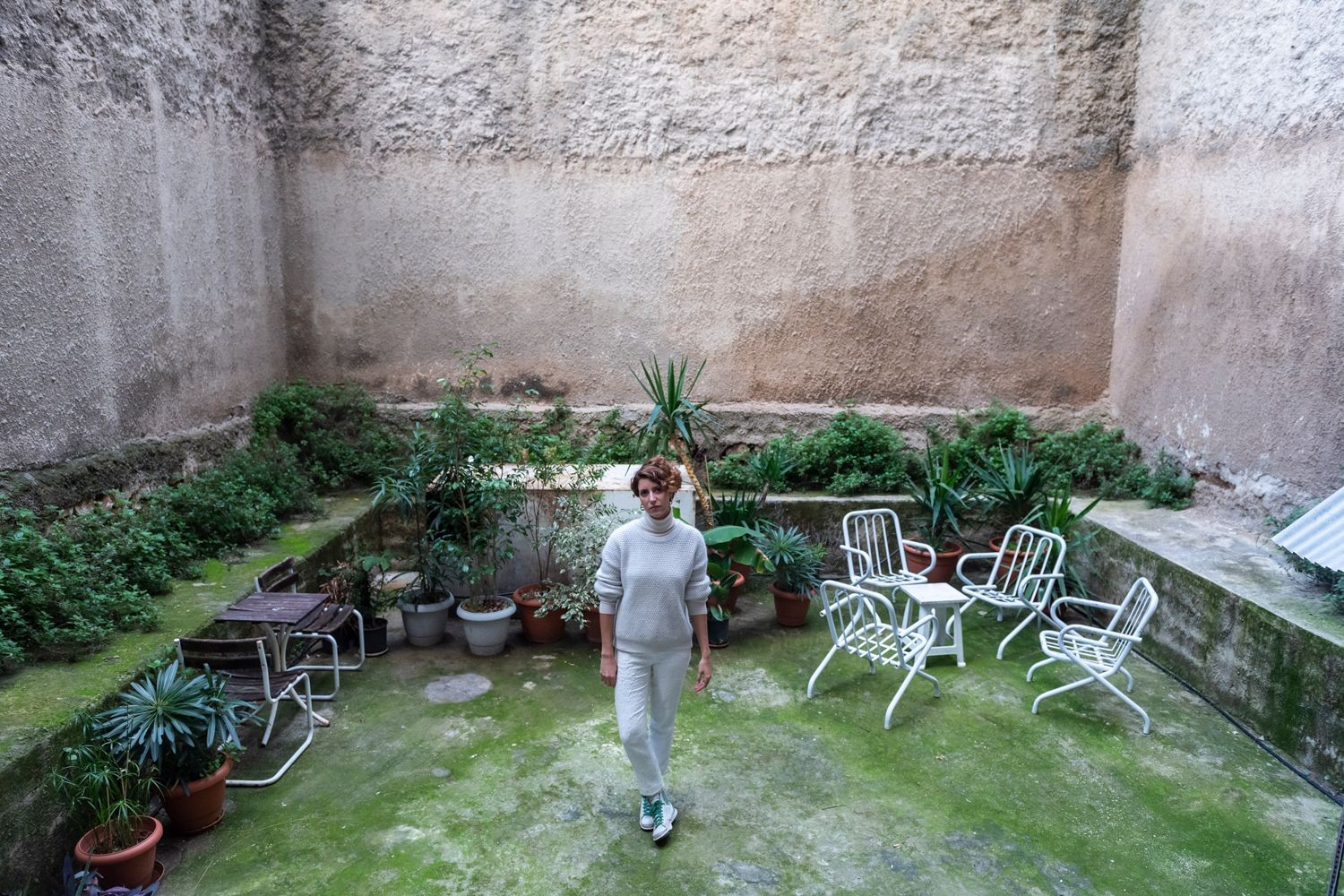
.jpg)
 (1).jpg)

